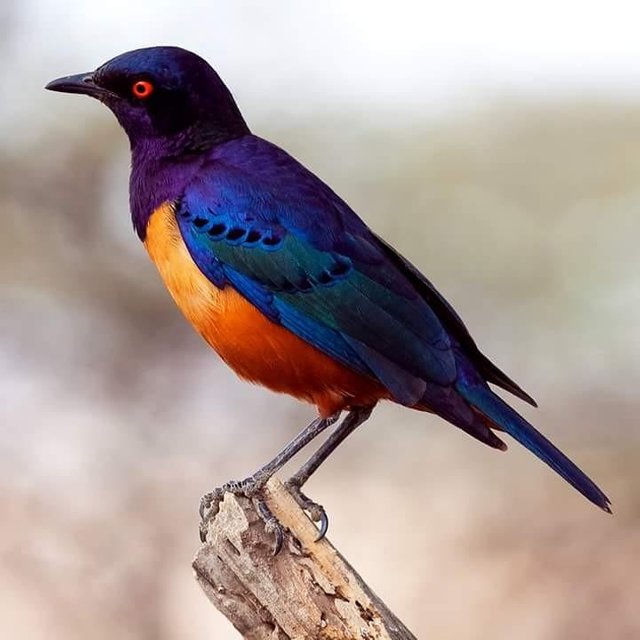
Some starlings imitate the song of many other birds. A starling couple can build a nest in 1-3 days. Both sexes incubate.
Range
The Hildebrandt's Starlings occur naturally in north-central Kenya south to the adjacent north central Tanzania; where they occupy between 1,600–7,200 ft (500 - 2,200 m).
They inhabit open woodland and thornbrush country.
Description
Hildebrandt's Starlings measure about 7.1 inches (18 cm) in length including the tail and weigh from 1.8 - 2.4 oz (50–69 g).
The adult plumage is mostly a bluish or publish black on top with a bright iridescence to it. The head is blue; the throat and upper chest are glossy purple, and the tail is glossy blue-green. The wings are bronze-green with blue primary wing feathers.
The middle chest and upper abdomen are orangey-buff. The lower abdomen is reddish-brown or rust colored.
The eyes are orange-red. The bill and legs are black.
Males and females look alike.
The juvenile plumage lacks the iridescence of the adult. The plumage is charcoal on top and chestnut brown below.
Breeding / Nesting
Hildebrandt's Starlings typically nest in March to May and October to December. However, in parts of Kenya, most breeding activities are observed between May to July.
Even though they generally breed in pairs, cooperative breeding has also been recorded on occasion.
They nest in tree cavities, often constructing the nest out of plant fibers and placing it into abandoned woodpecker nests.
The average clutch consists of 3 - 4 eggs. Both parents raise the young.
Feeding
The Hildebrandt's Starling mostly feed on insects, such as beetles, grasshoppers and flying terminates; as well as fruits, including, such as Carissa edulis, Euclea, Rhus and Apodytes dimidiata.
They typically forage on the ground, but may catch insects in flight.
They may join mixed feeding flocks of other starlings.
Vocalizations
Its contact call is described as sounding like "chule"; its alarm or sentinel call like "chu-ee" and its song as a slow low "ch-rak ch-rak chee-chee-wee chee-wee rak rak rak".
dsupreme!! Thank you, your Post.
Downvoting a post can decrease pending rewards and make it less visible. Common reasons:
Submit
Hi! I am a robot. I just upvoted you! I found similar content that readers might be interested in:
https://www.beautyofbirds.com/hildebrandtsstarlings.html
Downvoting a post can decrease pending rewards and make it less visible. Common reasons:
Submit